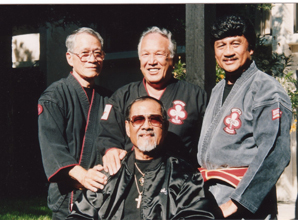 Professor Adriano D. Emperado is credited for the
founding of the Kajukenbo Self-Defense System in
Peter Y.Y. Choo – Tang Soo Do Karate
(KA) Frank F. Ordonez – Sekeino Ju Jitsu
(JU) Joseph Holck – Kodokan Judo/Danzan Ju Jitsu
(JU) George “Clarence” Chang – Sil Lum Gung Fu
(BO) During these two years, these instructors struggled
together and came up with the first working origin of the Kajukembo system. Their prime objective was to form the ultimate in self
defense. Not limited to any one particular style or form. Since no man is
the same in fighting techniques, variations in style become more and more
evident as more schools were open. At first, Kajukembo was a combination of the arts with
a heavy accent on Kempo Karate. The most major change occurred in 1959 when
Sijo Emperado incorporated “Ch’uan Fa” Kung Fu into Kajukembo. This art, a
soft style, stresses more emphasis on the “Ken-Bo” segment of Kajukembo and
its’ basis is the combining of both the Northern and Southern styles of the
Chinese martial arts. The Northern styles are characterized more by their
long range techniques and the Southern styles by their close in fighting
techniques. They were combined to form an all around fighting system with
the emphasis on practicality and self defense. The roots of the Kempo system can be traced back to One of Mitoses students was a man named William Kwai
Sun Chow. Chow had prior training in his father’s own Kung Fu methods as
well as extensive Judo experience. This background allowed him to combine
principles of combat with more creative freedom than his teacher, Mitose. Chow also taught small classes and in it was a young
protégé, Adriano D. Emperado. Emperado had come to him an already polished
martial artist, having begun his training in the late 1930’s with Filipino
Escrima, first with “Isaac”, then “Alejandro” and finally “Alfredo Peralta”. In 1943 Emperado began his study of “Kodokan Judo” with
Sensei Taneo at the Palama Settlement Gym. Then he advance his studies to
Kenpo JuJitsu with Professor Chow, first at the Catholic Youth Organization,
then later at the Kaheka Gym on He attended instructor’s advanced training given by
Professor Mitose in 1951. These classes were held at Professor Mitoses
residence and at the gym located on During this period, Emperado was training 8-12 hours a
day, pursuing a convergence point for all that he had learned. Always hungry
for more, he used the tough streets of the notorious Palama District for his
laboratory.
In an article written in the November 1966 issue of
Black Belt Magazine, the is an article about “Lua”, a bone breaking form of
personal defense. It was the martial art of the body guards of the Hawaiian
Kings. Some say it was the deadliest form of unarmed self-defense ever
invented. The late Professor Henry S. Okazaki (Joseph Holck’s instructor),
was quoted as saying, “While Lua had many similarities to JuJitsu, the
Hawaiian art was more effective”. It is now considered to be a lost art. In the same article, the last paragraph is quoted;
“But
while Lua and other arts gradually died out, the legacy of violent defense
form still hangs on. A recent example was the famous, or infamous, depending
upon how one looks at it, EMPERADO SCHOOL OF KARATE which was so prominent
only a short time ago. This type of lawless karate was so rugged that some
of the students were reported to have to fortified themselves with several
stiff belts of liquor before class in order to be able to endure the rough
going over they got from their instructors. With this type of background, it
is little wonder that today’s Hawaiians are so proficient in the modern, and
more disciplined forms of Japanese martial arts”. 
|
|